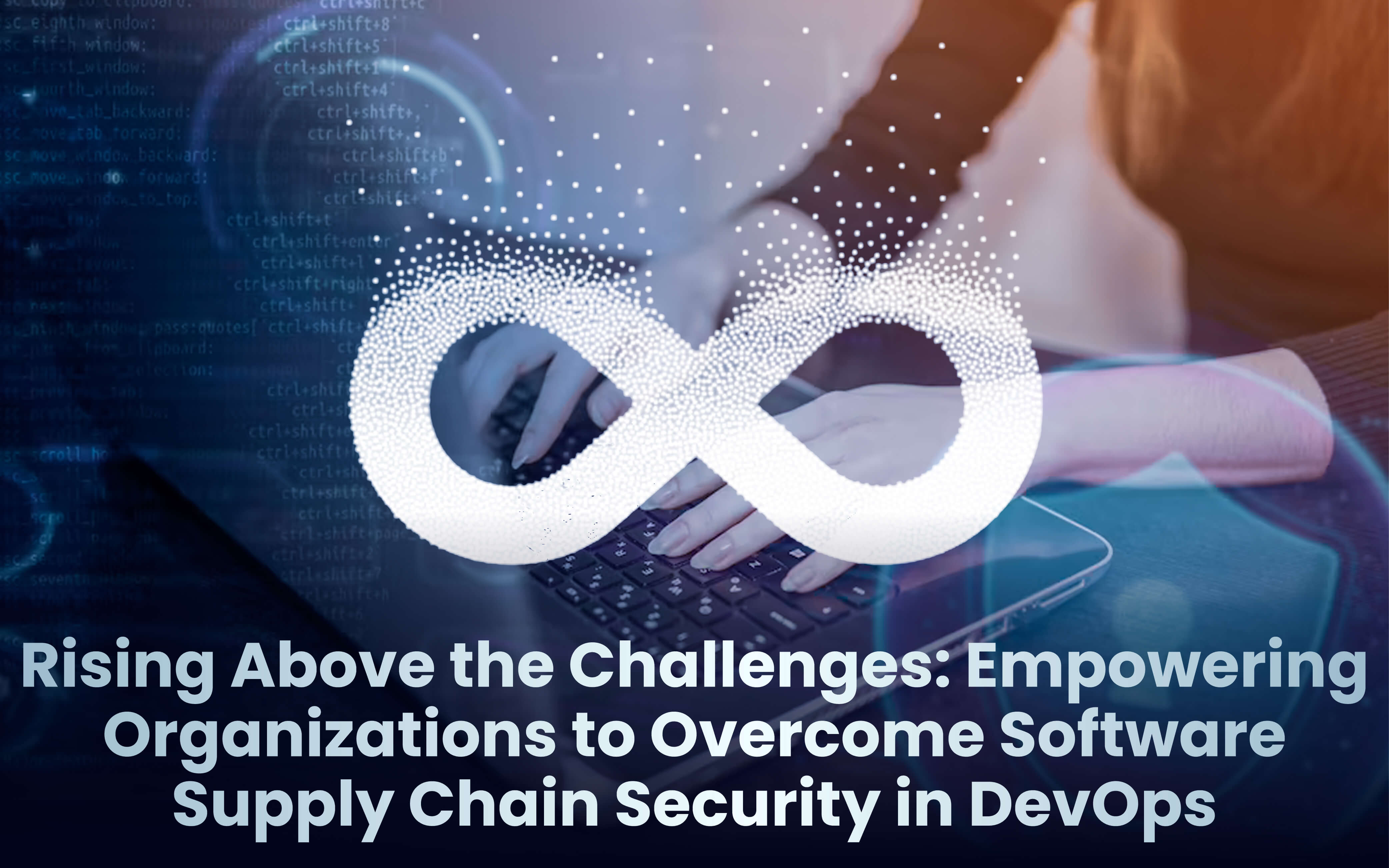Blogs
To know about all things Digitisation and Innovation read our blogs here.
DevOps
Rising Above the Challenges: Empowering Organizations to Overcome Software Supply Chain Security in DevOps
SID Global Solutions
22 May 2023

Introduction
In today’s fast-paced digital landscape, where organizations strive for rapid software development and deployment, DevOps has emerged as a game-changer. DevOps practices enable seamless collaboration between development and operations teams, facilitating faster time-to-market and improved efficiency. However, amidst the benefits, software supply chain security challenges persist, posing significant risks to organizations. In this comprehensive guide, we will delve into the complexities of software supply chain security in the DevOps environment and explore strategies to empower organizations to overcome these challenges effectively.
Also Read: DevOps Security Checklist To Safeguard Your Software Development Process
Understanding Software Supply Chain Security in DevOps
- Definition and Importance: Software supply chain security in DevOps refers to the protection of software applications and systems from vulnerabilities, threats, and attacks that can occur within the supply chain of software development and deployment. It involves ensuring the integrity, authenticity, and confidentiality of software components throughout the entire lifecycle. The importance of software supply chain security lies in safeguarding organizations from potential risks that can lead to data breaches, unauthorized access, and disruptions in operations.
- Common Vulnerabilities and Risks: Software supply chain security faces various vulnerabilities and risks, including:
- Insecure or outdated software dependencies: The use of outdated or vulnerable third-party components can introduce security flaws into the software.
- Lack of visibility and control: Limited visibility into the software supply chain can make it challenging to identify and mitigate potential risks.
- Supply chain attacks: Adversaries may compromise the supply chain by injecting malicious code or tampering with software components.
- Open source vulnerabilities: Open source libraries and frameworks may contain vulnerabilities that can be exploited.
The Evolving Threat Landscape
- New and Emerging Threats: The threat landscape in software supply chain security is constantly evolving. New and emerging threats include:
- Malware and ransomware attacks: Malicious actors may introduce malware or ransomware into the software supply chain to gain unauthorized access or disrupt operations.
- Zero-day vulnerabilities: Unknown vulnerabilities in software components can be exploited before patches or fixes are available.
- Advanced persistent threats (APTs): APTs are sophisticated, targeted attacks that aim to compromise software supply chains to gain long-term access to systems and sensitive data.
- Insider threats: Internal actors with privileged access may intentionally or unintentionally introduce vulnerabilities or compromise the supply chain.
- Impact on Software Supply Chain Security: The evolving threat landscape poses significant challenges to software supply chain security. It highlights the need for organizations to stay proactive, continually update security measures, and adopt advanced technologies and practices to detect and mitigate potential risks effectively.
Also Read: Why Observability is Crucial for Modern Software Systems?
Key Challenges in Software Supply Chain Security
- Lack of Visibility and Control: Organizations often struggle to maintain visibility and control over the entire software supply chain, including third-party components and dependencies. This lack of visibility can lead to difficulties in identifying and addressing vulnerabilities or unauthorized changes.
- Third-Party Dependencies and Risks: Dependencies on third-party software components introduce risks, as these components may have vulnerabilities or be compromised. Managing and assessing these dependencies become critical to ensure their integrity and security.
- Vulnerabilities in Open Source Components: Open source components, although widely used and beneficial, can introduce security risks. Organizations need to have mechanisms in place to identify and address vulnerabilities in open source libraries and frameworks.
- Supply Chain Attacks and Countermeasures: Supply chain attacks involve compromising software components or the distribution process to inject malicious code. Organizations must implement measures such as code signing, secure distribution channels, and software verification to counter such attacks.
Best Practices for Enhancing Software Supply Chain Security in DevOps
- Implementing Secure Development Practices: Secure development practices, such as secure coding, secure configurations, and secure architecture design, help minimize vulnerabilities from the early stages of software development.
- Establishing a Robust Software Bill of Materials (SBOM): Creating and maintaining an accurate and up-to-date SBOM provides visibility into the software components, dependencies, and their associated vulnerabilities, enabling organizations to assess and manage risks effectively.
- Continuous Monitoring and Vulnerability Management: Continuous monitoring involves actively monitoring the software supply chain for any anomalies or suspicious activities. Vulnerability management focuses on regularly scanning and assessing software components for known vulnerabilities and promptly applying patches or updates.
- Third-Party Risk Management: Effective third-party risk management includes conducting thorough assessments of third-party vendors, evaluating their security practices, and implementing contracts or agreements that define security requirements and responsibilities.
- Security Automation and Orchestration: Automation and orchestration of security processes help streamline and integrate security practices into the DevOps workflow. This includes automating security testing, vulnerability scanning, and deployment processes to ensure consistent security measures throughout the software supply chain.
Also Read: Revisiting Monolithic Architecture: Amazon’s Return to Simplicity
DevSecOps: Integrating Security into the DevOps Workflow
- Shifting Left – Incorporating Security Early in the Software Development Lifecycle: Shifting left refers to integrating security practices as early as possible in the software development lifecycle (SDLC). By introducing security considerations during the requirements and design phases, organizations can proactively address potential vulnerabilities.
- Collaboration and Communication between Development, Operations, and Security Teams: Effective collaboration and communication between development, operations, and security teams ensure that security requirements and concerns are adequately addressed throughout the DevOps process. This involves establishing clear channels of communication and fostering a culture of shared responsibility.
- Security Testing and Continuous Integration: Security testing should be an integral part of the continuous integration/continuous delivery (CI/CD) pipeline. Regular security testing, including static application security testing (SAST) and dynamic application security testing (DAST), helps identify and remediate vulnerabilities early in the software development process.
- Security as Code – Infrastructure as Code and Configuration Management: Treating security as code involves managing infrastructure and configurations using version control and automation tools. Infrastructure as code (IaC) and configuration management enable consistent and secure provisioning of resources and environments.
Building a Culture of Security
- Security Awareness and Training Programs: Promoting security awareness and providing training programs to employees help foster a culture of security. This includes educating developers, operations teams, and other stakeholders about secure coding practices, threat awareness, and incident response procedures.
- Leadership Support and Organizational Alignment: Leadership support is essential for driving a culture of security. Executives should prioritize and allocate resources to ensure that security measures are integrated into the organizational strategy and that security goals align with business objectives.
- Accountability and Responsibility: Establishing clear lines of accountability and responsibility for security helps ensure that all stakeholders understand their roles and obligations. This includes defining roles such as security champions, who act as advocates for security practices within their respective teams.
Also Read: Securing Your Supply Chain: A Deep Dive into DevSecOps Implementation
Tools and Technologies for Software Supply Chain Security
- Static Application Security Testing (SAST): SAST tools analyze the source code of software applications to identify potential security vulnerabilities and coding errors. These tools help developers detect and remediate security flaws early in the development process.
- Software Composition Analysis (SCA): SCA tools scan software dependencies and open source components to identify known vulnerabilities and license compliance issues. They provide visibility into the composition of software supply chains and help manage associated risks.
- Continuous Security Monitoring: Continuous security monitoring tools monitor the software supply chain for security threats, anomalous behavior, and suspicious activities. These tools enable real-time detection and response to security incidents.
- Threat Intelligence Platforms: Threat intelligence platforms gather and analyze threat data from various sources to provide insights into potential security risks and emerging threats. These platforms assist organizations in making informed decisions regarding their software supply chain security
Compliance and Regulatory Considerations
- GDPR, CCPA, and Other Data Privacy Regulations: Organizations need to consider data privacy regulations such as the General Data Protection Regulation (GDPR) and the California Consumer Privacy Act (CCPA) when managing software supply chain security. Compliance with these regulations ensures the protection of personal data and strengthens overall security practices.
- Industry Standards and Frameworks: Adhering to industry standards and frameworks, such as ISO 27001 and NIST Cybersecurity Framework, provides organizations with a structured approach to software supply chain security. These standards outline best practices and guidelines for managing security risks effectively.
- Auditing and Reporting: Regular audits and reporting help organizations assess the effectiveness of their software supply chain security measures. It enables them to identify gaps, address compliance requirements, and communicate security posture to stakeholders.
Also Read: The Evolution of APIs: How Simple Integrations Grew into Complex Ecosystems
Building Resilience – Incident Response and Recovery
- Incident Response Planning: Developing a comprehensive incident response plan ensures organizations are prepared to respond effectively to security incidents. The plan should define roles, responsibilities, and processes for detecting, containing, and mitigating the impact of security breaches.
- Detection and Containment: Rapid detection and containment of security incidents are crucial to minimizing their impact. This involves utilizing security monitoring tools, performing real-time analysis, and implementing measures to isolate and contain affected systems.
- Recovery and Lessons Learned: After an incident, organizations should focus on recovery efforts and learning from the incident to prevent similar occurrences in the future. This includes restoring systems, reviewing incident response effectiveness, and updating security practices based on lessons learned.
Conclusion
As organizations continue to embrace DevOps practices, it is crucial to recognize and address the software supply chain security challenges that persist. By understanding the evolving threat landscape, implementing best practices, integrating security into the DevOps workflow, fostering a culture of security, and leveraging appropriate tools and technologies, organizations can rise above these challenges and empower themselves to overcome software supply chain security risks. With a comprehensive approach to software supply chain security, organizations can enhance their resilience, protect their valuable assets, and drive successful software delivery in the DevOps era.









